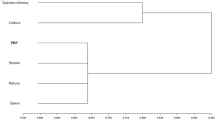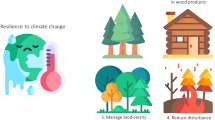Abstract
Forests play an important role, contributing to human health and well-being as environments for recreation and rehabilitation. Stress has become a significant problem in modern societies, and the importance of forests as environments for stress relief has been recognized in recent years. To maintain and create forests for rehabilitation, consideration of their rehabilitation value needs to be incorporated into forest management planning and to do this, we need to define and quantify the characteristics of good rehabilitation forests. This study presents an approach for including rehabilitation value as an aspect of forest management planning. This approach is applied to three case study areas in northern, middle and southern Sweden to identify trade-offs between maintaining high wood production while creating forest areas suitable for rehabilitation from stress-related diseases. The results show that quite large areas of rehabilitation forest (10–15 % of total forest area) can be maintained at a relatively small loss in economic net present value (NPV) of wood production (ca 2 % of maximum NPV). When using the rehabilitation value indicator defined in this study, age and spatial variables (distance to roads and water) seem to be the most limiting factors.




Similar content being viewed by others
References
Adevi A, Mårtensson F (2013) Stress rehabilitation through garden therapy: the garden as a place in the recovery from stress. Urban For Urban Green. 12(2):30–237
Annerstedt M, Norman J, Boman M, Mattsson L, Grahn P, Währborg P (2010) Finding stress relief in a forest. Ecol Bull 53:33–42
Brunberg T (1995) Basic data for productivity norms for heavy-duty single-grip harvesters in final felling. Skogforsk, Redogörelse 8. (In Swedish with English summary.)
Brunberg T (1997) Underlag för produktionsnorm för engreppsskördare i gallring. Skogforsk, Redogörelse 8. (In Swedish with English summary.)
Brunberg T (2004) Underlag till produktionsnorm för skotare. Skogforsk, Redogörelse 3. (In Swedish with English summary.)
Davis LS, Johnson KN, Bettinger PS, Howard TE (2001) Forest Management, 4th edn. McGraw-Hill, New York
Edwards DM, Jay M, Jensen FS, Lucas B, Marzano M, Montagné C, Peace A, Weiss W (2010) Public preferences for silvicultural attributes of European forests. EFORWOOD Report D2.3.3, Forest Research, UK
Edwards DM, Jay M, Jensen FS, Lucas B, Marzano M, Montagné C, Peace A, Weiss G (2012) Public preferences across Europe for different forest stand types as sites for recreation. Ecol Soc. 17(1): article 27
Eriksson L, Lindhagen A (2001) A model indicating effects of multi-purpose use of forestry at the stand level. In: Niskanen A, Väyrynen J (eds) Economic sustainability of small-scale forestry. European Forest Institute, Joensuu, pp 161–176
Gatersleben B, Andrews M (2013) When walking in nature is not restorative—the role of prospect and refuge. Health Place 20:91–101
Gesler WM (1992) Therapeutic landscapes: medical issues in light of the new cultural geography. Soc Sci Med 34(7):735–746
Gesler WM (1993) Therapeutic landscapes: theory and a case study of Epidaurus Greece. Environ Plan D Soc Space 34(7):735–746
Glise K (2014) Exhaustion disorder—identification, characterization and course of illness. Doctoral thesis. The Sahlgrenska Academy and the University of Gothenburg, Gothenburg
Grahn P, Stigsdotter U (2010) The relationship between perceived sensory dimensions of urban green space and stress recovery. Landsc Urban Plan 94:264–275
Gundersen VS, Frivold LH (2008) Public preferences for forest structures: a review of quantitative surveys from Finland, Norway and Sweden. Urban For Urban Green 7:241–258
Hartig T (2004) Restorative environments. In: Spielberger C (ed) Encyclopedia of applied psychology, vol 3. Elsevier, Amsterdam
Hartig T, Cooper Marcus C (2006) Essay. Healing gardens—places for nature in health care. Lancet 368:36–37
Hartig T, Evans GW, Jamner LD, Davis DS, Gärling T (2003) Tracking restoration in natural and urban field settings. J Environ Psychol 23(2):109–123
Johnson KN, Scheurman HL (1977) Techniques for prescribing optimal timber harvest and investment under different objectives—discussion and synthesis. For Sci. Monograph 18 (Supplement to For Sci 23(1))
Kangas J, Store R, Kangas A (2005) Socioecological landscape planning approach and multicriteria acceptability analysis in multiple-purpose forest management. For Policy Econ 7(4):603–614
Kaplan S (1995) The restorative benefits of nature: toward an integrative framework. J Environ Psychol 15:169–182
Kaplan R, Kaplan S (1989) The experience of nature: a psychological perspective. Cambridge University Press, New York
Korpela KM (2003) Negative mood and adult place preference. Environ Behav 35(3):331–346
Morita E, Fukuda S, Nagano J, Hamajima N, Yamamoto H, Iwai I, Nakashima T, Ohira H, Shirakawa T (2007) Psychological effects of forest environments on healthy adults: Shinrin-yoku (forest-air bathing, walking) as a possible method of stress reduction. Public Health 121(1):54–63
Nilsson K, Sangster M, Konijnendijk CC (2011) Forest, trees and human health and wellbeing: inroduction. In: Nilsson K, Sangster M, Gallis C, Hartig T, de Vries S, Seeland K, Schipperijn J (eds) Forest, trees and human health. Springer, Berlin, pp 1–19
Nordh H, Grahn P, Währborg P (2009) Meaningful activities in the forest, a way back from exhaustion and long-term sick leave. Urban For Urban Green 8(3):207–219
Nordström E-M, Eriksson LO, Öhman K (2011) Multiple criteria decision analysis with consideration to place-specific values in participatory forest planning. Silva Fenn 45(2):253–265
Öhman K, Edenius L, Mikusiński G (2011) Optimizing spatial habitat suitability and timber revenue in long-term forest planning. Can J Forest Res 41(3):543–551
Ottosson J, Grahn P (2008) The role of natural settings in crisis rehabilitation: how does the level of crisis influence the response to experiences of nature with regard to measures of rehabilitation? Landsc Res 33(1):51–70
Pálsdottír AM, Persson D, Persson B, Grahn P (2014) The journey of recovery and empowerment embraced by nature—clients’ perspectives on nature-based rehabilitation in relation to the role of the natural environment. Int J Environ Res Public Health 11(7):7094–7115
Pukkala T, Kellomäki S, Mustonen E (1988) Prediction of the amenity of a tree stand. Scand J Forest Res 3:533–544
Pukkala T, Nuutinen T, Kangas J (1995) Integrating scenic and recreational amenities into numerical forest planning. Landsc Urban Plan 32(3):185–195
Sonntag-Öström E (2014) Forests for rest. Recovery from exhaustion disorder. Doctoral Dissertation. Umeå University, Umeå
Sonntag-Öström E, Nordin M, Slunga Järvholm L, Lundell Y, Brännström R, Dolling A (2011) Can the boreal forest be used for rehabilitation and recovery from stress-related exhaustion? A pilot study. Scand J For Res 26(3):245–256
Sonntag-Öström E, Nordin M, Lundell Y, Dolling A, Wiklund U, Karlsson M, Carlberg B, Slunga Järvholm L (2014) Restorative effects of visits to urban and forest environments in patients with exhaustion disorder. Urban For Urban Green 13(2):344–354
Stigsdotter UK, Palsdottir A-M, Burls A, Chermaz A, Ferrini F, Grahn P (2011) Nature-based therapeutic interventions. In: Nilsson K, Sangster M, Gallis C, Hartig T, de Vries S, Seeland K, Schipperijn J (eds) Forests, trees and human health and well-being. Springer, Berlin, pp 309–342
Stoltz J, Grahn P, Skärbäck E, van den Bosch M, Lundell Y, Nordström E-M, Dolling A (under review) Evaluation of restorative qualities in forest stands using available forest stand data. Eur J For Res
Store R (2009) Sustainable locating of different forest uses. Land Use Policy 26(3):610–618
Tenngart Ivarsson C, Abramsson K (2006) Nature and health in Sweden. In: Hassink J, van Dijk M (eds) Farming for health. Green-care farming across Europe and the United States of America. Springer, Berlin, pp 127–134
Tyrväinen L, Ojala A, Korpela K, Lanki T, Tsunetsugu Y, Kagawa T (2014) The influence of urban green environments on stress relief measures: a field experiment. J Environ Psychol 38:1–9
Ulrich RS (1984) View through a window may influence recovery from surgery. Science 224(4647):420–421
Ulrich RS, Simons RF, Losito BD, Fiorito E, Miles MA, Zelson M (1991) Stress recovery during exposure to natural and urban environments. J Environ Psychol 11:201–230
Umaerus P, Lidestav G, Eriksson LO, Högvall Nordin M (2013) Gendered business activities in family farm forestry: from round wood delivery to health service. Scand J For Res 28(6):596–607
Velarde MD, Fry G, Tveit M (2007) Health effects of viewing landscapes—landscape types in environmental psychology. Urban For Urban Green 6:199–212
Währborg P, Petersson I, Grahn P (2014) Nature-assisted rehabilitation for reactions to severe stress and/or depression in a rehabilitation garden: long-term follow-up including comparisons with a matched population-based reference cohort. J Rehabil Med 46(3):271–276
Wakefield S, McMullan C (2005) Healing in places of decline: (re)imagining everyday landscapes in Hamilton Ontario. Health Place 11(4):299–312
Ward Thompson C (2011) Linking landscape and health: the recurring theme. Landsc Urban Plan 99(3–4):187–195
White M, Smith A, Humphryes K, Pahl S, Snelling D, Depledge M (2010) Blue space: the importance of water for preference, affect, and restorativeness ratings of natural and built scenes. J Environ Psychol 30(4):482–493
Wikström P, Edenius L, Elfving B, Eriksson LO, Lämås T, Sonesson J, Öhman K, Wallerman J, Waller C, Klintebäck F (2011) The Heureka forestry decision support system: an overview. Math Comput For Nat Resour Sci 3(2):87–95
Acknowledgments
This work was supported by the Forest Society Foundation (Stiftelsen Skogssällskapet) under Grant 1011-78/150-7 and by the Faculty of Forest Sciences at the Swedish University of Agricultural Sciences as a part of the research program Forest and Health. We thank Karin Öhman, Hampus Holmström and Ljusk Ola Eriksson for Heureka support as well as creative discussions about treatment simulations and the optimization model. We also thank two anonymous reviewers for their constructive comments.
Conflict of interest
The authors declare that there are no conflicts of interest.
Author information
Authors and Affiliations
Corresponding author
Additional information
Communicated by Martin Moog.
Rights and permissions
About this article
Cite this article
Nordström, EM., Dolling, A., Skärbäck, E. et al. Forests for wood production and stress recovery: trade-offs in long-term forest management planning. Eur J Forest Res 134, 755–767 (2015). https://doi.org/10.1007/s10342-015-0887-x
Received:
Revised:
Accepted:
Published:
Issue Date:
DOI: https://doi.org/10.1007/s10342-015-0887-x




